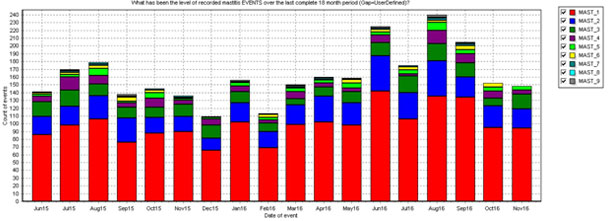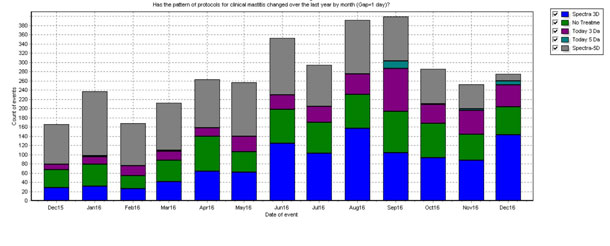This month’s VAS DC305 tip is on clinical mastitis. Clinical mastitis is a very costly disease. Although poor milk procedures, dirty environments and faulty equipment can predispose cows, most mastitis is caused by an infectious agent. Treatment of mastitis (MAST event in DC305) caused by certain bacteria is not improved by antibiotic therapy, so not treating those cows will decrease antibiotic use, decrease hospital days and decrease milk withheld from sale.
In addition, treatable cases are not negatively affected by waiting approximately 24 hours to start therapy. With DC305, dairies are now able to automate processes and import into the program culture results from a certified laboratory or an on-farm laboratory. Dairies can identify the pathogen prior to treatment so they know whether to treat or not to treat. With pathogen-guided therapy, dairies have the potential to reduce antibiotic use and see an economic savings.
Working closely with the dairy’s veterinarian is very important to set up the correct protocols based on the culture result. In order to automate MAST based on pathogen ID, the diagnosis, data entry and treatment protocols need to be standardized. This creates nearly foolproof hospital treatment lists, and greatly facilitates MAST analysis and drug tracking.
Hospital lists are used daily to assure that all protocols are followed and animals are treated according to culture results (see Figure 1).
Once this program is set up and in place, valuable data is available for monitoring protocols and analysis. GUIDE can be used to assist you in looking at clinical mastitis (see Figure 2).
The following clinical mastitis questions are answered:
• Has the recorded monthly level and risk per cow for first mastitis events changed (see Figure 3)?
• How has the level of recorded mastitis EVENTS over the last 18-month period (with the gap of your choice) changed? Gap is used to define what is a new case of mastitis (see Figure 4).
• Has the pattern of protocols for clinical mastitis changed over the last year by month? This lets you see what protocols are being used and if changes have been made (see Figure 5).
• Has the pattern of subsequent mastitis-related actions recorded after clinical mastitis changed? This allows you to see if protocols for repeat treatments have changed (see Figure 6).
Click on the images above to view them in more detail.
Using DC305 and pathogen-based mastitis treatment will decrease antibiotic use and increase economic savings. It also provides you with valuable management information for monitoring protocols and mastitis levels.
– Article submitted by VAS
View the previous tip, parlor performance reports.








.jpg?t=1687979285&width=640)


